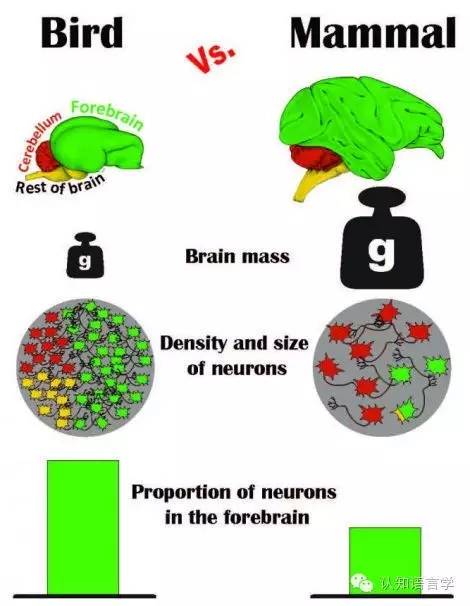入门语言学教材中一般都会有一个表述:语言学是以人类语言(speech)为研究对象的。想必会有同学曾经脑洞大开:为什么是speech?我们是不是还可以研究bird sound甚至是海豚音呢?虽然语言学家一般不关心这些问题(一些语言学家还真研究了brid sound的语法结构,以后再做介绍),但很多心理学家的实证研究正在一步步向我们揭示鸟类的很多认知机制的生理基础,并有惊人的发现!
今年五月份发表在PNSA(美国科学院院报)上的一篇研究文章指出:鸟类大脑中的神经元的密度高于很多哺乳动物,甚至高于某些灵长类!这似乎能解释为什么鹦鹉能学舌,很多鸟儿那建筑师般的筑巢技能。
先来看个视频,了解各大概:
接下来看看英文报道:
Published in the Proceedings of the National Academy of Sciences, this study is the first to systematically measure the number of neurons in the brains of more than a dozen bird species, from tiny zebra finches to the six-foot-tall emu. By doing so, neuroscientist Suzana Herculano-Houzel and her team at Vanderbilt University discovered that avian brains contain more neurons per square inch than mammalian brains.
This means that birds pack more brain power per pound than mammals, offering an explanation for their remarkable cognitive talents. What’s more, the study shows that evolution has found more than one way to build a complex brain.
Scientists have long wondered how birds—with their teeny-tiny brains—are capable of exhibiting many complex behaviors, some of which were thought to the be exclusive domain of larger primates. Birds can manufacture tools, cache food, plan for the future, pass the mirror test, use insight to solve problems, and understand cause-and-effect. They’ve also been observed to hide food in front of other birds, and then relocate that food when the other birds aren’t looking. This suggests that birds have a “theory of mind,” which means they’re capable of inferring what other birds are thinking. Very few animals can do that.
Prior to this, scientists just figured that avian brains were simply wired in a completely different way compared to primate brains. But this theory hasn’t been borne out empirically; studies have shown that avian brains are structured quite similarly to mammalian brains.
Now the tired old notion that birds are stupid is starting to fall by the wayside. “We found that birds, especially songbirds and parrots, have surprisingly large numbers of neurons in their pallium [or forebrain]: the part of the brain that corresponds to the cerebral cortex, which supports higher cognition functions such as planning for the future or finding patterns,” said Herculano-Houzel. “That explains why they exhibit levels of cognition at least as complex as primates.”

The parrot, for example, has as many neurons in its walnut-sized brain as the macaque monkey, which has a larger brain about the size of a lemon. When the functional connectivity of avian brains are mapped, it looks similar to what’s found in mammals, such as mice, cats, monkeys, and even humans.
But by packing these neurons in such a dense fashion, birds have been endowed with higher cognitive power per pound than mammals.
“In designing brains, nature has two parameters it can play with: the size and number of neurons and the distribution of neurons across different brain centers,” said Herculano-Houzel, “and in birds we find that nature has used both of them.”
The researchers aren’t sure which of the two brain types evolved more recently. It’s possible that the super-compact avian brains came first, and that mammals evolved a “different” kind of brain. Or perhaps birds, who are descended from dinosaurs, evolved their highly efficient brains as a requisite for flight, since birds need to be light and agile.
More conceptually, a growing number of scientists, bioethicists, and legal scholars have been making the case that highly sapient and cognitively complex animals should be awarded personhood status, which would afford them special protections. So, in addition to all great apes (a group that includes humans), whales, dolphins, and elephants, we should also include certain birds, such as corvids and parrots.